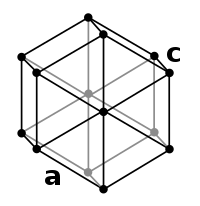
Photo from wikipedia
Abstract Elevated arsenic (As) and fluoride (F) in natural water present an urgent environmental concern. The demand for their effective removal underscores the fundamental understanding of their solid-liquid interface chemistry.… Click to show full abstract
Abstract Elevated arsenic (As) and fluoride (F) in natural water present an urgent environmental concern. The demand for their effective removal underscores the fundamental understanding of their solid-liquid interface chemistry. Herein, the efficiency of {2 0 1} TiO2 in As(III/V) and F was explored using macroscopic and molecular-level techniques. Their adsorption isotherms followed the Langmuir equation, and the maximum adsorption capacity was 50.5, 29.3, and 5.0 mg/g for As(III), As(V) and F, respectively. Their adsorption kinetics of As(III), As(V) and F conformed to the pseudo-second-order model. The XPS and in situ ATR-FTIR results identified that the active adsorption sites on {2 0 1} TiO2 included surface hydroxyl groups, but not oxygen vacancies. As(III/V) and F form bidentate binuclear and monodentate mononuclear structures, respectively, regardless of exposed facets. Integrated with the molecular-level mechanism, the charge distribution multisite complexation model well predicted the pH edge behaviors in mono- and co-component systems. The shift of pHPZC of {2 0 1} TiO2 in competitive adsorption systems signified the formation of inner-sphere complexes. The results of this study shed new lights on the adsorption of coexisting ions using high-index faceted TiO2.
Journal Title: Applied Surface Science
Year Published: 2019
Link to full text (if available)
Share on Social Media: Sign Up to like & get
recommendations!